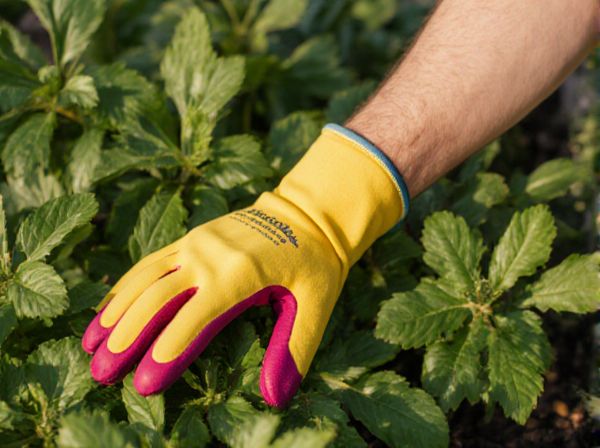
Deadheading vs Pinching Illustration
Deadheading involves removing spent flowers to encourage continuous blooming and maintain plant health, while pinching targets the growth tips to promote bushier, more compact plants. Both techniques enhance plant aesthetics and vigor by directing energy towards new growth and preventing leggy development. Effective use of deadheading and pinching ensures a longer flowering period and robust plant structure.
Table of Comparison
| Feature | Deadheading | Pinching |
|---|---|---|
| Definition | Removing dead or faded flowers to encourage new blooms | Pinching off young shoots to promote bushier growth |
| Purpose | Extend flowering period and improve plant appearance | Enhance plant fullness and shape |
| Timing | After flowers fade or die | Early growing season, when shoots are soft |
| Plant Types | Annuals, perennials, flowering shrubs | Herbs, houseplants, annuals |
| Effect on Plant | Boosts flower production by redirecting energy | Stimulates lateral branching and denser growth |
| Tools Needed | Hand snips or fingers | Fingers or pruning shears |
Deadheading vs Pinching: Key Differences
Deadheading involves removing spent flowers to encourage new blooms and extend the flowering period, while pinching focuses on trimming young shoots to promote bushier growth. Deadheading targets mature blossoms to improve overall plant appearance and health, whereas pinching modifies plant shape early in development for structural benefits. Both techniques optimize plant growth but serve distinct purposes in horticultural practices.
What Is Deadheading in Plants?
Deadheading in plants involves removing spent flowers to encourage new blooms and improve overall plant health. This practice prevents seed formation, redirecting the plant's energy into growth and flowering rather than seed production. Regular deadheading promotes prolonged blooming periods and maintains the plant's aesthetic appeal.
How Pinching Promotes Plant Growth
Pinching stimulates plant growth by removing the growing tip, which encourages the development of lateral buds and results in a fuller, bushier plant structure. This technique redirects the plant's energy from vertical extension to producing more branches and foliage, enhancing overall vigor and bloom density. Unlike deadheading, which focuses on removing spent flowers to prolong blooming, pinching actively shapes the plant's growth pattern for improved foliage and flower production.
Benefits of Deadheading Flowers
Deadheading flowers promotes continuous blooming by removing spent blooms, which directs the plant's energy toward producing new flowers rather than seed development. This process enhances overall plant appearance and health, reducing the risk of disease and pest infestations associated with decaying flowers. Regular deadheading improves nutrient allocation and encourages a more prolific and vibrant floral display.
When to Choose Pinching Over Deadheading
Pinching is ideal during the early growth stages of plants, particularly for promoting bushier foliage and increased branching in herbs and annuals. Deadheading is more suited for removing spent flowers to encourage continuous blooming in established flowering plants. Choose pinching over deadheading when the goal is to shape young plants and stimulate fuller development rather than just prolonging flowering.
Tools Needed for Deadheading and Pinching
Deadheading requires tools such as sharp garden scissors or pruning shears to cleanly remove spent flowers and promote continuous blooming. Pinching involves using fingers or small, precise pruning tools to pinch off new shoots and encourage bushier growth. Both techniques benefit from clean, sterilized tools to prevent disease transmission and ensure plant health.
Step-by-Step Guide to Deadheading
Deadheading involves removing spent flowers to promote continuous blooming, starting by locating wilted blooms and cutting just above the first set of healthy leaves or buds using clean, sharp scissors or pruning shears. Each cut should be precise to avoid damaging the stem, encouraging the plant to redirect energy towards new growth and flower production. Regular deadheading extends the plant's flowering period and maintains a neat, attractive appearance.
How to Properly Pinch Back Plants
To properly pinch back plants, use your thumb and forefinger to gently remove the stem tips just above a leaf node, encouraging bushier growth and more blooms. Pinching should be done regularly during the growing season, especially on young plants, to prevent legginess and promote a fuller structure. Avoid removing too much at once--pinch just a small portion to stimulate growth without stressing the plant.
Common Mistakes in Deadheading and Pinching
Deadheading often suffers from the mistake of removing flower buds prematurely, which can stunt new growth and reduce bloom longevity. Pinching errors commonly include cutting too low on the stem, leading to weak regrowth or plant stress. Proper timing and technique are crucial for promoting healthy development and maximizing flowering potential.
Best Practices for Healthier, Fuller Plants
Deadheading involves removing spent flowers to encourage continuous blooming and prevent seed formation, promoting healthier plant growth. Pinching is the practice of trimming new growth tips to stimulate branching, resulting in fuller and bushier plants. Combining deadheading and pinching enhances overall plant vitality, maximizing flower production and improving foliage density.
Deadheading vs Pinching Infographic

 gardendif.com
gardendif.com